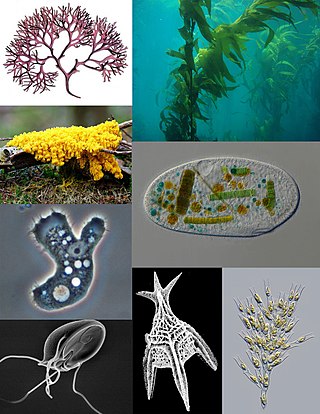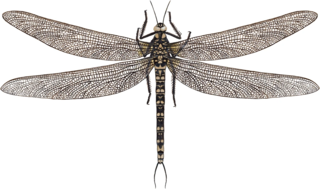
In zoological nomenclature, a type species is the species name with which the name of a genus or subgenus is considered to be permanently taxonomically associated, i.e., the species that contains the biological type specimen. A similar concept is used for suprageneric groups and called a type genus.

In biology, a type is a particular specimen of an organism to which the scientific name of that organism is formally associated. In other words, a type is an example that serves to anchor or centralizes the defining features of that particular taxon. In older usage, a type was a taxon rather than a specimen.

Wastebasket taxon is a term used by some taxonomists to refer to a taxon that has the purpose of classifying organisms that do not fit anywhere else. They are typically defined by either their designated members' often superficial similarity to each other, or their lack of one or more distinct character states or by their not belonging to one or more other taxa. Wastebasket taxa are by definition either paraphyletic or polyphyletic, and are therefore not considered valid taxa under strict cladistic rules of taxonomy. The name of a wastebasket taxon may in some cases be retained as the designation of an evolutionary grade, however.

Caturus is an extinct genus of predatory marine fishes in the family Caturidae in the order Amiiformes, related to modern bowfin. It has been suggested that the genus is non-monophyletic with respect to other caturid genera.
In zoological nomenclature, the valid name of a taxon is the correct scientific name for that taxon. The valid name must be used for that taxon, regardless of any other name that may currently be used for that taxon, or may previously have been used. A name can only be valid when it is an available name under the International Code of Zoological Nomenclature (ICZN); if a name is unavailable, then it cannot be considered either valid or invalid.

Gyposaurus is a genus of basal sauropodomorph dinosaur from the early Jurassic of South Africa. It is usually considered to represent juveniles of other prosauropods, but "G." sinensis is regarded as a possibly valid species.
The Botanical and Zoological Codes of nomenclature treat the concept of synonymy differently.

Drepanosaurs are a group of extinct reptiles that lived between the Carnian and Rhaetian stages of the late Triassic Period, approximately between 230 and 210 million years ago. The various species of drepanosaurs were characterized by a bird-like skull, a barrell shaped body, and a horizontally narrow tail. A number of drepanosaurs had specialized grasping limbs and often prehensile tails similar to those of chameleons. Drepanosaurs are generally thought to have been arboreal (tree-dwelling), and probably insectivores. Some studies have alternately suggested fossorial (digging) and aquatic lifestyles for some members. Fossils of drepanosaurs have been found in North America and Europe. The name is taken from the family's namesake genus Drepanosaurus, which means "sickle lizard," a reference to their strongly curved claws.

Cimolichthys is an extinct genus of large predatory marine aulopiform fish known worldwide from the Late Cretaceous. It is the only member of the family Cimolichthyidae.
Coelacanthopsis is an extinct genus of marine coelacanth which lived during the early Carboniferous (Mississippian). It is known from one species, C. curta from the Viséan of Ardross, Scotland.

The Odonatoptera are a superorder of ancient winged insects, placed in the probably paraphyletic group Palaeoptera. The dragonflies and damselflies are the only living members of this group, which was far more diverse in the late Paleozoic and contained gigantic species, including the griffinflies of the order Meganisoptera. This lineage dates back at least to the Bashkirian, not quite 320 million years ago.
Gogodipterus is an extinct genus of prehistoric marine lungfish in the family Chirodipteridae. It contains a single species, G. paddyensis, known from the Late Devonian Gogo Formation of Western Australia. It was formerly placed in Chirodipterus.
Cycloptychius is an extinct genus of prehistoric freshwater & marine ray-finned fish that existed throughout much of the Carboniferous period in Eurasia, and possibly into the Early Permian in South Africa. It was a member of the Rhadinichthyidae, a family of basal ray-finned fish that was formerly placed in the now-paraphyletic order Palaeonisciformes.

Nomen illegitimum is a technical term used mainly in botany. It is usually abbreviated as nom. illeg. Although the International Code of Nomenclature for algae, fungi, and plants uses Latin terms as qualifiers for taxon names, the definition of each term is in English rather than Latin. The Latin abbreviations are widely used by botanists and mycologists.

Brachyopomorpha is a clade of stereospondyl temnospondyls within the infraorder Trematosauria. It was constructed in 2000 to include Bothriceps australis and the superfamily Brachyopoidea. It is phylogenetically defined as a stem-based taxon including Pelorocephalus and all taxa closer to it than to Rhytidosteus. In contrast, Brachyopoidea is defined as a node-based taxon including Brachyops and Pelorocephalus and all descendants of their most recent common ancestor. Because Bothriceps is not thought to be a descendant of that recent common ancestor and would be more basal than it, the genus is placed just outside Brachyopoidea and is considered to be a sister taxon to the clade.

Libelluloidea is a superfamily of dragonflies.

Cyathaspidiformes is an extinct order of heterostracan vertebrates known from extensive fossil remains primarily from Silurian to Early Devonian strata of Europe, and North America, and from Early Devonian marine strata of Siberia.

Anglaspis is an extinct genus of cyathaspidiform heterostracan agnathan. Fossils are found in marine strata of Europe, from the late Silurian period until the genus' extinction during the Early Devonian. As with other cyathaspidiforms, individuals of Anglaspis had dorsal and ventral plates covering the forebody, gill pouches, and nasal openings that lay on the roof of the oral cavity.

Paraliliaspis egregia is an extinct cyathaspidiform heterostracan agnathan from early Devonian marine strata of the Ural Mountains.

Ariaspidae is a family of extinct cyathaspidiform heterostracan agnathans in the suborder Cyathaspidida.















